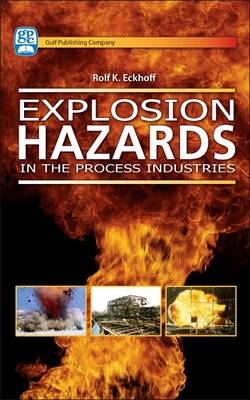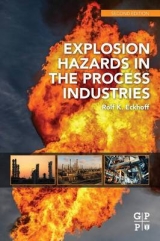
Explosion Hazards in the Process Industries
Gulf Publishing Company (Verlag)
978-0-9765113-4-2 (ISBN)
- Titel erscheint in neuer Auflage
- Artikel merken
Explosions in the process industries injure or kill hundreds, if not thousands, of workers every year. They occur in process plants, refineries, platforms and pipelines all over the world. Millions of dollars are spent repairing damages, replacing equipment and rebuilding facilities in the wake of this destruction. This book explores different types of explosions that can occur in a facility and the necessary steps to guard against them. A clear set of preventative measures, rules and standards combine to make this book a convenient guide to real-world applications. Additional theoretical issues in the use of probabilistic equations and scenarios make this book an absolute necessity for process industry safety.
Rolf K. Eckhoff is Professor Emeritus of Process Safety Technology in the Department of Physics and Technology at University of Bergen, Norway. He is also concurrent professor at Northeastern University, Shen-yang, China, and Scientific Advisor at Oresund Safety Advisors AB, Malmo, Sweden. He is the author of Dust Explosions in the Process Industries, first published in 1991 with an extended version published in 2003. He is also the author and co-author of more than 150 technical and scientific publications and more than 130 research reports. He has advised Industry committees on numerous occasions, lectured to courses, conferences, and seminars in a number of countries in Europe, Bahrain, Isreal, China, India, Australia, Canada, and the US. Dr. Eckhoff earned a Masters in Science in Chemical Engineering from the University of Trondheim, a Master of Philosophy from the University of London, a Doctor Technicae in Dust Explosions from the University of Trondheim, and a Doctor of Science (Eng.) degree from the University of London.
Preface
About the Author
1 Introduction
1.1 Process Safety—a Persistent Challenge to Educators
1.2 What is an Explosion?
1.3 Accidental Explosions—a Real Hazard in the Process Industries
1.4 Basic Differences in How and Where Explosive Gas, Spray/Mist, and Dust Clouds are Likely to Be Generated
1.5 European Union Definition of Explosive Atmospheres
1.6 The “Human Factor
2 Gas and Vapor Cloud Explosions
2.1 Combustion of Gases and Vapors
2.2 Ignition of Premixed Gas/Vapor and Air
2.3 Case Histories of Accidental Gas/Vapor Cloud Explosions
2.4 Means of Preventing and Mitigating Gas/Vapor Explosions in the Process Industries
3 Explosions in Clouds of Liquid Droplets in Air (Spray/Mist)
3.1 Introduction
3.2 Generation of Clouds Liquid Droplets in Air (Spray/Mist)
3.3 Combustion of Clouds of Liquid Droplets in Air (Spray/Mist)
3.4 Ignition of Clouds of Liquid Droplets in Air (Spray/Mist)
3.5 Case Histories of Spray/Mist Explosions
3.6 Means of Preventing and Mitigating Spray/Mist Explosions in the Process Industries
4 Gas and Dust Explosions Caused by Smoldering Combustion in Powder Layers and Deposits
4.1 Combustion Velocities/Rates in Powder Layers/Deposits
4.2 Initiation of Combustion in Powder/Dust Layers and Deposits
4.3 Explosion Initiation Processes by Smoldering/Glowing Material
4.4 Case Histories of Accidental Smoldering Combustion in Silos, Resulting in Gas Explosions, and Adopted Extinction Procedures
4.5 Measures for Preventing Excessive Self-Heating in Silos
5 Dust Explosions
5.1 What is a Dust Explosion?
5.2 Combustion of Dust Clouds in Air
5.3 Ignition of Dust Clouds in Air
5.4 Case Histories of Dust Explosions
5.5 Means of Preventing and Mitigating Dust Explosions in the Process Industries
6 Explosives, Pyrotechnics, and Propellants
6.1 Chemical Composition of Some Explosives
6.2 Combustion Propagation in Explosives/Pyrotechnics/Propellants
6.3 Ignition/Initiation of Explosives/Pyrotechnics/Propellants
6.4 Case Histories of Accidental Explosives/Pyrotechnics/Propellants Explosions
6.5 Measures for Preventing and Mitigating Accidental Explosions of Explosives, Propellants, and Pyrotechnics
7 Design of Electrical Apparatuses for Hazardous Areas
7.1 Classification of Hazardous Areas
7.2 Basic Design Concepts for Electrical Apparatus
8 Outline of Methods for Hazard and Risk Analysis
8.1 Introduction
8.2 Hazard Surveys or Inventories
8.3 Hazard and Operability Studies (HAZOP) and Failure Modes and Effects Analysis (FMEA)
8.4 Analysis of Systems Reliability by Fault Tree Analysis
8.5 Quantitative Risk Analysis by Event Tree Analysis
8.6 Safety Audits
References
Index
| Verlagsort | Austin |
|---|---|
| Sprache | englisch |
| Gewicht | 850 g |
| Themenwelt | Technik ► Elektrotechnik / Energietechnik |
| ISBN-10 | 0-9765113-4-7 / 0976511347 |
| ISBN-13 | 978-0-9765113-4-2 / 9780976511342 |
| Zustand | Neuware |
| Haben Sie eine Frage zum Produkt? |
aus dem Bereich



